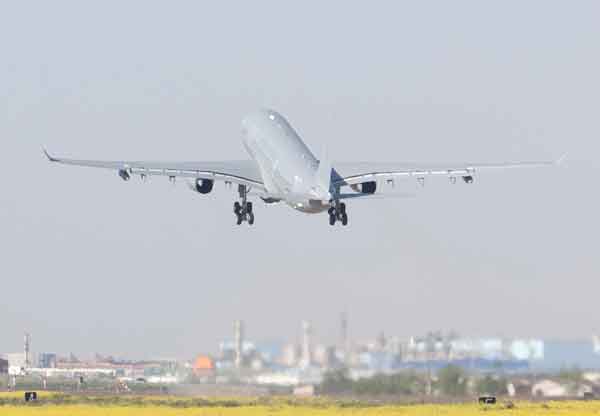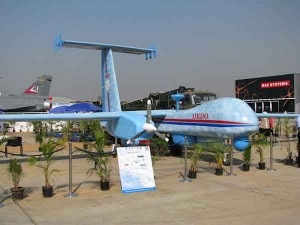The fleet of IL-76-based AWACS aircraft is being augmented by a fleet of Embraer-145 based Airborne Early Warning and Control (AEW&C) system aircraft which will provide the second tier of airborne surveillance feeding information to the AWACS operating as the ADDC. This semi-indigenous system has been developed through collaboration between Embraer of Brazil that has provided three Embraer 145 jets as the basic platform for $210 million and the Centre for Airborne Systems (CABS), a laboratory under the Indian Defence Research and Development Organisation (DRDO) that provides the radar system with Active Array Antenna Unit (AAAU), various other sub-systems and associated equipment. The total cost of the project for three AEW&C systems is estimated at Rs. 1.8 billion. The first of the three AEW&C aircraft contracted for arrived at Bangalore, India, in August 2012 for integration of the radar and further testing before its induction into the IAF. Two more systems are to follow and are expected to be delivered by 2015, some three years behind the originally envisaged schedule. These platforms will provide a 240-degree surveillance coverage over a distance of up to 375km and the aircraft would be able to on station continuously for five hours.
The IAF is going in for a major upgrade programme for its fleet of Searcher Mk II and Heron UAVs…
The long term requirement of airborne surveillance aircraft for the country, i.e. a mix of AWACS and AEW&C aircraft is assessed as a minimum of 20 platforms. So far, a total of eight platforms have been contracted for of which four have already been inducted. Three of these are operational.
Unmanned Aerial Vehicles
With increasing reliance on technology and automation in warfare, indications are that air forces the world over as also in India, will become increasingly dependent on Unmanned Aerial Vehicles (UAVs). The IAF currently operates the Searcher Mk II and the Heron for surveillance and reconnaissance. It also operates the Harop or the Harpy Unmanned Combat Aerial Vehicles (UCAV) designed to home on to enemy radar emissions, destroying both itself and the enemy radar. These unmanned aerial systems can loiter over a battlefield and can be used against high value targets as and when the opportunity arises. These systems can also be employed for Suppression of Enemy Air Defences (SEAD) missions. All these platforms are from Israel Aerospace Industries (IAI) and the induction began with the Searcher Mk II after an agreement was entered into with IAI in 1996. The IAF also operates the Lakshya manufactured by the DRDO which serves as towed aerial targets for live fire training.
With the help of IAI, the IAF is going in for a major upgrade programme for its fleet of Searcher Mk II and Heron UAVs. After the upgrade, the IAF will be able to operate the UAVs from thousands of miles away through satellite communication data link.
The IAF has floated a tender for 60 UAVs for which two Israeli firms, including Innocon and Blue Bird Aero systems have expressed their interest in offering their unmanned aerial systems. The Israeli UAV manufacturer Innocon in collaboration with an Indian partner has offered the ‘Spider’ for the Indian UAV tender. Weighing 2.5kg without payload and battery, the ‘Spider’ UAV has an endurance of 30 mins.
The ADE is developing the largely indigenous Rustom II which will be in the same class as the Predator of the US.
Blue Bird which is involved in the design, development and production of tactical unmanned aerial systems, is offering its one-kg Micro B air vehicle. Blue Bird also has an agreement with Bangalore’s Dynamatic Technologies Ltd. for the manufacturing, assembly and marketing of mini and micro tactical UAVs in India. The Indian tender stipulates that the weight of the UAV itself should not exceed 5.50lb and the maximum all up weight at 33lb. The IAF has also submitted a request for information to international suppliers for an Unmanned Combat Air Vehicle (UCAV) with low radar cross-section, high service ceiling, an expected range of 500nm (925 km) and the capability to carry precision-guided weapons in an internal weapons bay.
On the indigenous front, the Bangalore-based Aeronautical Development Establishment (ADE), a laboratory under the DRDO, in collaboration with HAL and Bharat Electronics Limited, is developing a Medium Altitude Long Endurance (MALE) UAV designated as the “Rustom 1”. This UAV will augment and ultimately replace the IAI Heron. After a shaky start, the flight test phase is progressing well. The Rustom 1 will be capable of missions such as reconnaissance, surveillance, target acquisition, target designation, communications relay, battle damage assessment and signal intelligence.
The ADE is also developing the largely indigenous Rustom II which will be in the same class as the Predator of the US. It will field advanced capabilities, additional payloads and an endurance of 24 hours. Maiden flight is scheduled for February 2014 and the $342.25 million Rustom II project for ten Rustom-2 UAVs, spare vehicles and support equipment is planned to be completed by August 2017. Also on the drawing board at the ADE is an Autonomous Unmanned Research Aircraft dubbed as the AURA which essentially is a UCAV. Meant for induction into the IAF and built on the “Flying Wing” concept, the AURA UCAV will be a tactical stealth aircraft, with large percentage of composites in the airframe, would have internally carried weapons and would be capable of delivering laser-guided air-to-surface weapons. It would be powered by a turbofan engine.
How the IAF copes with the challenges in the future will hinge substantially on the quality and integration of entire range of Force Multipliers…
Another novel concept the ADE is working on is the development of a solar powered High Altitude Long Endurance (HALE) UAV capable of carrying a payload of sensors weighing up to 50kg for surveillance and reconnaissance tasks. This will be an all-weather, long-range, high endurance UAV with sorties at an altitude of 30,000 feet and lasting up to 30 days. It will have specially designed solar panels to provide power by night and in cloudy weather conditions from the reserve of energy generated earlier and stored in fuel cells.
Apart from special mission platforms, the IAF has also acquired a variety of other facilities in the regime of Force Multipliers. Notable amongst these is the commissioning in 2010 of modern, state-of-the-art, fully secure and reliable network and digital information grid called Air Force Network. This facility has replaced the communication network of the IAF that was based on primitive tropo-scatter technology making the IAF a truly net-centric combat force. The IAF is also inducting an array of Precision Guided Munitions, Aerostats, simulators and is also embarked on a major programme for modernisation of airfields, all designed to enhance core operational capability. How the IAF copes with the challenges in the future will hinge substantially on the quality and integration of entire range of Force Multipliers with the overall force structure.







AMCA is a highly advanced project taken up by a country like India. HAL TEJAS project started in 1980’s and still it has not been fully deployed in Indian Armed forces. What do you think, should India wait for the AMCA or Dassault Rafale deal or should India have gone for the F-35 Lightning 2 by American aviation giant Lockheed Martin ?
Dear Sir,
You speak of 20 years (two decades) to make an expansion as per above information. This is a very very long period and by then our counter part will double their existing military power.
We need great infrastructure in India, so that abundant foreign investment comes in and we develop all our industries to maximize exports. Among those industries must be the military equipment as a major part.
The R&D for military equipment must grow 8 folds, which must include Aircraft, Ships, Tanks, Battle Guns, intelligence equipment and of course missiles.
Hope this is understood now or tomorrow we will not be the leaders in the South Asia, but followers.
Thanking you
with regards
MOHAN JANGA
Never look back,what ever has happened,happened but plz now on don’t buy any defence item from the shelf. Any thing we intend to buy should be manufactured here ,if not possible then at least total transfer of technology mst be there. We have very talented technical talent if given the opportunity,resources & the political will which seems to there now,be able to deliver the best defence systems. Regards. Dev bhardwaj
Please find the result for the indiigenous development of any advence weapons and reveal to the world after induction to our force.
It will boost morality of our army and research organizations, Start work on Tejas II & fifth generation aircraft or delivery weapons and reveal to the world during induction. JAI HIND
…about commenting”Hi dude, what ever you said is true these guys are wiatsng time on commenting…But the fact is that the work culture in our government research institutes is worst compared to any other private research organizations. I have seen the work culture as being one of them (not DRDO or defence) and i didn’t able to work in that environment with them and I took off from the country and working abroad. It’s obvious to strive for personal achievements for any human along with professional goals. We can see so many projects like Arjun, Kaveri, Tejas etc., which have been delayed by decades and at higher costs than estimated. This effected our armed forces in two ways. 1. By the time of final product was showed, the requirements of armed forces were changed substantially, 2. Armed forces spend billions of dollars to other countries to fulfill their requirement or using the old equipment (because of the politicians). And you know how many engineers and science graduates from premiere institutes like IIT’s, NIT’s and Universities are staying at home, very few and they are working in other countries for what ever the reason it might be (personal or professional). As you said if we want to comment on someone there will be two cases 1. for bad propaganda and 2. pain caused by the love for them.I don’t think the people commenting here are the former case people. They want their country to be at top, but the pain caused by the DRDO makes them to comment like this.
Throwing comments on other is easy than doing job. Even a paper plane takes time for us if we start from sctrach without prior knowledge. Once we have something we know where to go and how to go. This saves time and actual returns of our earlier investment. Since DRDO has sufficient knowledge about missiles so the made AGNI V at short notice. To achieve that level DRDO spent around 30 years.Private firms pay huge salary because their workforce is very less compared to government. To increase the salary of an engineer is not an easy job. For that they need to raise the scale of his salary. Once raised that applies to all other engineers belongs all other government institutions falls under that scale. That means few hundred thousands of people. DRDO dudes are working under harsh conditions in all respects and yet again they are achiving success. We many not even survive 10 days in those conditions. Hats-off to them and let us do our part to make our country better. So stop hate comments and start doing something.
Thank you. But I’d certainly liked to have more posts on this one. This is a central issue which we’re going to have to deal with.
Jaganniwas Iyer